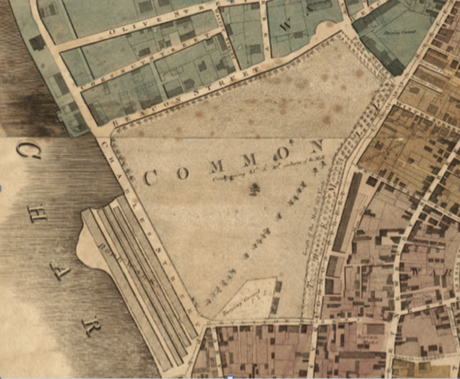 There are many quirky stories about Boston Common and features of the park that have since disappeared. Are the stories true or is it just fiction? The Wishing Stone on the Common qualifies as both quirky and true.
There are many quirky stories about Boston Common and features of the park that have since disappeared. Are the stories true or is it just fiction? The Wishing Stone on the Common qualifies as both quirky and true.
A popular feature of the Common in the early days was the Wishing Stone. Unfortunately, no illustrations exist, but it was a large granite boulder near the junction of the Beacon Street Mall and the path leading to Joy Street and according to the superstition at the time, the young people used to walk around it nine times (!) and then sit or stand on it to silently make their wishes. It apparently was blown up (as in detonated) around 1820, though the reason for the destruction is lost to time. The Wishing Stone is mentioned by well-known authors from the era, as a unique feature on Boston Common.
A biography of Louisa May Alcott by Madeline B. Stern mentions the Wishing Stone several times. "Once, in her zeal to make the Wishing Stone grant her wish, Louy (Louisa May Alcott's nickname) drove not only her hoop into that very Frog Pond, but her own self after it."
Edward Everett Hale, beloved Bostonian with his own statue in the Public Garden, mentions the Wishing Stone in his memoir "Historic Boston and its Neighborhood". Hale was showing the Dean of Westminster around Boston in 1878, "We took a carriage at once, quite early in the afternoon, and went first that he might see where the Wishing Stone was, and so down to the iron fence which surrounds the relics of the Old Elm."
Many things never change, and the Common has always provided an outlet for the energies of the young. From the eighteenth century, "It is safe to say, moreover, that just because it was the playground of so many Bostonians of the older generations, it has taken a hold upon the affections and imaginations which time has not relaxed. They look back upon it, much as they remember the country holidays of childhood, with a particular fondness. And why should they not? There was the Frog Pond for the water-supply of firemen's play-outs, for the sailing of toy boats in summer, for skating in winter. There was the Wishing Stone, near the Joy Street gate, a rough rock on and round it was the custom to perform certain ritual observances in the belief that wishes made upon their completion would come true." Boston Common Scenes from Four Centuries by M.A. DeWolfe Howe.
Some historical context for the time on Boston Common. Throughout the Colonial years, the Common was a focal point of military activity. From its shore, Redcoats departed on April 18, 1775 for Lexington and Concord. Entering the evacuated town a year later, George Washington inspected the Common, badly battered but reclaimed forever-after as a source of civic pride. The Massachusetts State House was constructed in 1797, and many new residences were built along Tremont, Park and Beacon Streets. The famous architect Charles Bulfinch designed the State House and under his direction, the center of Boston developed a dignified classical style. By 1830, the city had banished the cows and added tree-lined malls and paths. Where it had been green pasture, by 1851 approximately 1,255 elms and evergreens graced the Common. Through all that change, the Wishing Stone played a role in the lore of the Common and the community."
